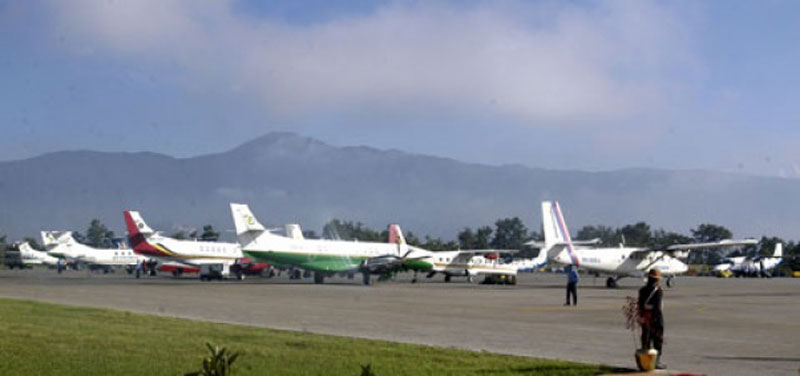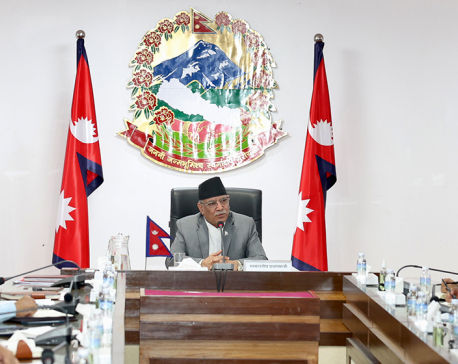
OR

Another domestic-only airport is a non-starter given the complexities of managing two airports in close proximity
Kathmandu airport is renowned as a place where aircrafts are kept on hold for hours in the sky for the want of parking space on ground. Arriving and departing traffic from the TIA have to share the same flight path. Things were not so difficult when flights were sparse. But increasing number of domestic fleet/flights and ever-increasing number of international airlines has only exacerbated the daytime problem. And to put it bluntly, it is not likely to be resolved anytime soon. Our airport improvement projects do not get done in time, as is also seen with an ongoing project. Concerned department finds it convenient, by habit, to let new problems crop up rather than foresee them in advance and devise ways to tackle them.
TIA’s single runway, with unidirectional landing/departing compulsion, has to manage the needs of wide-bodies, narrow-bodies, big and small domestic turboprops and even helicopters. That is not all. The domestic fleet now even boasts of a couple of 50-seater jets, with more arriving in the near future. Have Nepalis become so status conscious that we need jets to visit other domestic hubs? Cosmic Air tried this gimmick some years ago with a 100-seater aircraft. The company was shut down under questionable circumstances, leaving a trail of casualties in its wake.
It is natural for the responsible minister to be concerned about state of his subordinate departments that have been hitting headlines for all the wrong reasons. So, as expected, we had a minister (with subordinates in tow) visiting the TIA complex, examining dustbins and duty free shop and what not.
Going by the headlines, we heard about terminal expansion plans and construction of aero bridges to ease “air traffic congestion”!
It was also reported that the minister issued a 12-point declaration directing the CAAN, the national civil aviation regulator, to start the process of constructing a “domestic only” airport east of Kathmandu in Kavre. We had a similar directive issued by another minister not long ago. We do not know how seriously his directive was taken back then. Such off-the-cuff directives often make for sensational headlines. But selecting a suitable airstrip site is not that simple. Theoretically, an ideal location needs flat space with ample length and width, and it should be appropriately oriented with regard to general wind direction in the area. It must also have fairly good all-around visibility unobstructed by terrain.
But prospective areas are seldom ideally located and compromises have to be made. For example an extreme level of compromise seems to have been made in case of strips at Jiri and Lukla. Built in the 1960s by the Swiss, the Jiri strip remains invisible until a sharp river bend is negotiated. Lukla, in spite of its popularity, can be taken as unsafe if landing needs to be aborted at the last moment. Because of the steep approach and high terrain at the other end of the runway, it is known the world over as one of the most dangerous airports in use.
Ongoing TIA congestion was the result of reckless policy of granting permission to any and all carriers in the alluring hope of getting more tourists. In any case, it should be TIA granting the timing slots rather than the airlines. The airport has relatively less traffic in late evening hours and it will be logical to divert traffic to such hours. Further, it is deplorable even to think about letting TIA operate round-the-clock as it is bang in the middle of the city, not an off-shore one like Kansai (in Japan).
New “domestic only” airport may look logical but it is a non-starter given the complexities of having two airports in such close proximity. Even with most basic facilities a new airport will not be cheap.
This will be compounded by the operational problems, most importantly in managing air traffic.
Added administrative cost and duplication of logistics will add more headaches. Passengers will suffer in having to fork out more for commuting. In any case, it may be at least another ten years before another airport becomes operational, if it ever does.
We also heard about the possibility of the heliport, built just east of the TIA runway, being relocated to another area to make room for aircraft parking. There was serious construction related issues with regard to the said helipad. It is not that it cannot be done but it will require redoing the pavement anew so that it does not peel off or crack as it did earlier under helicopter’s puny weight. This will be another big project and may not be operational before three to four years, at the earliest.
The parking issue at TIA is bound to get much worse as we will have more Nepal-registered jets including two wide bodies that will soon need designated parking slots. How will we be able to provide slots to other airlines if even the few available are occupied by domestic carriers? TIA has a very narrow spread with urban conurbation having spread right up to its periphery. There is not much expansion option unless we go to the extreme of claiming low lying areas within the precinct and in the vicinity; whether Nijgarh takes-off or not, TIA may eventually have to opt for this. “Wingtip to wingtip”, either on ground or in air, will be the rule here, not an exception.
harjyal@yahoo.com
You May Like This

Nepal's Forests in Flames: Echoes of Urgency and Hopeful Solutions
With the onset of the dry season, Nepal's forests undergo a transition from carbon sinks to carbon sources, emitting significant... Read More...

Live and let die, Sarkaar!
Some time ago, in a dazzling display of our Prime Minister’s political finesse, he revealed yet another populist spectacle; his... Read More...

'Victim blaming'- Nepali society's response to sexual violence
Multiple studies show that in most sexual assaults, the attacker is someone known and trusted by the victim. ... Read More...
Just In
- KMC to organize a month-long skill fair from May 1
- Birgunj Metropolis collects over Rs 360 million in revenue
- NEPSE plunges below 2,000 points after one and a half months; daily turnover declines to Rs 2.10 billion
- AI Index Report-2024: AI still behind humans on complex tasks like competition-level mathematics
- Daiji-Jogbudha road construction at snail’s pace
- Govt fails to adopt podway technology despite its potential in Nepal
- Jhulaghat border crossing in Baitadi to remain closed from this evening
- Universities will be free from partisan interests: Education Minister



















Leave A Comment